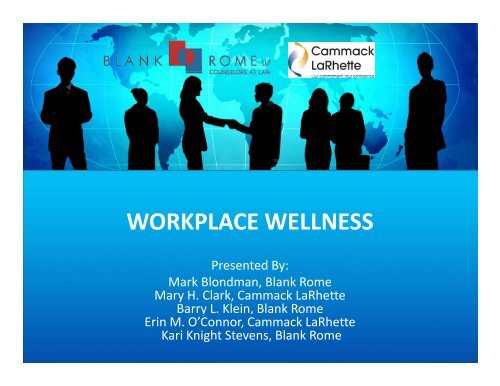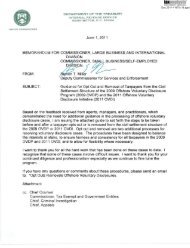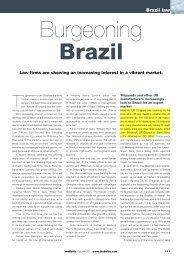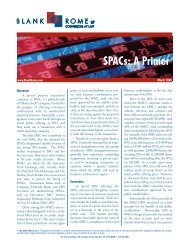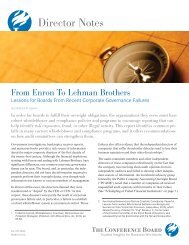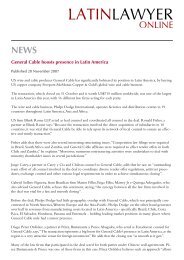WORKPLACE WELLNESS WORKPLACE ... - Blank Rome LLP
WORKPLACE WELLNESS WORKPLACE ... - Blank Rome LLP
WORKPLACE WELLNESS WORKPLACE ... - Blank Rome LLP
Create successful ePaper yourself
Turn your PDF publications into a flip-book with our unique Google optimized e-Paper software.
<strong>WORKPLACE</strong> <strong>WELLNESS</strong><br />
Presented By:<br />
Mark Blondman, <strong>Blank</strong> <strong>Rome</strong><br />
Mary H. Clark, Cammack LaRhette<br />
Barry L. Klein, <strong>Blank</strong> <strong>Rome</strong><br />
Erin M. O’Connor, Cammack LaRhette<br />
Kari Knight Stevens, <strong>Blank</strong> <strong>Rome</strong>
What We Mean When We Say “Wellness”<br />
“Wellness is a multidimensional state of being describing the existence of positive<br />
health in an individual as exemplified by quality of life and a sense of wellbeing.”<br />
–Charles B. Corbin from Arizona State University<br />
“Wellness” characteristics<br />
• A proactive, preventive, and holistic approach to health and well‐being<br />
• Closely linked to your lifestyle and the choices you make<br />
• Emphasizes integration and balance between physical, occupational,<br />
spiritual, financial, social and emotional health<br />
• Individual behaviors and attitudes toward personal activities such as<br />
exercise and healthy h eating<br />
• A process of reaching optimum levels of health and productivity<br />
• Impacts employer through lower health plan costs, absenteeism and<br />
presenteeism
Workplace Wellness<br />
Workplace/Worksite wellness refers to a health‐focused employee benefit that<br />
involves educational, financial, organizational, and environmental activities<br />
designed to help maintain good health and support long‐term health improvement.<br />
Programs vary greatly but generally include all or the combination of the following:<br />
risk identification tools, health management programs (including utilization and<br />
chronic condition management), behavior modification programs, value based<br />
benefit plan design, educational programs, and changes to the work environment.<br />
Characteristics include:<br />
• Reflects a commitment to healthy living<br />
• Culture of prevention<br />
• Promotes sustainable behavior change<br />
• Programs encourage and reward employees for making healthier choices<br />
– Aspect of personal responsibility<br />
• Aligns an employer’s interests with those of its employees to drive down<br />
lifestyle‐related health care and productivity costs.
Workplace Wellness Offerings<br />
• Health risk appraisals (HRAs)<br />
• Biometric screenings<br />
• Onsite or near‐site health center<br />
• Access to online, personalized health<br />
tracking tools<br />
• Health fairs<br />
• Programs to help with:<br />
– Tobacco cessation<br />
– Weight management (e.g. WeightWatchers)<br />
– Nutrition counseling<br />
– Mental Health/ Stress management<br />
– Exercise and fitness<br />
• Educational sessions or communications to<br />
improve health literacy<br />
• Walking programs<br />
• Contests/team challenges<br />
• Flu Shots<br />
• Financial Management<br />
• Disease Management<br />
• Online, telephonic, and mail‐based coaching<br />
• On‐site exercise classes or facilities / Gym<br />
membership discounts<br />
• Environment:<br />
– Remove environmental inconsistencies, such<br />
as unhealthy foods at meetings, in vending<br />
machines, or in the cafeteria.<br />
– Workspace ergonomic concerns<br />
– Tobacco‐free campus<br />
– Encouragement of work/life family balance<br />
• Childcare support
Workplace Wellness Legal Landscape<br />
• ERISA<br />
• GINA<br />
• HIPAA Nondiscrimination<br />
• HIPAA Privacy and Security<br />
• ADA<br />
• Health Care Reform<br />
• Title VII<br />
• Internal Revenue Code<br />
• ADEA<br />
• State Laws
The Business Case: Cost Containment<br />
Worksite wellness not only contributes to employee satisfaction. There is a strong<br />
financial/business case to be made for sponsoring a program.<br />
Healthcare Landscape:<br />
• The cost of healthcare is steadily increasing.<br />
It is outpacing growth in the economy, gross<br />
domestic production (GDP), inflation, and<br />
wages.<br />
• Today‘s existing Healthcare system cannot<br />
be sustained<br />
o As a nation, we cannot sustain the cost<br />
increases in our entitlement programs<br />
(Medicai, Medicare, Social Security,<br />
etc).<br />
• Sometime between 2030 and<br />
2040, mandatory spending will<br />
exceed government revenues<br />
o By 2019, health spending is expected<br />
to reach $4.5 trillion or 19% of GDP<br />
o Commercially insured plans provided<br />
through private employers cannot<br />
continue to absorb the increases<br />
hospitals seek in order to offset the<br />
losses from government payers on<br />
their balance sheets.<br />
This would only serve to deteriorate the health<br />
of the American population<br />
http://www.bizjournals.com/nashville/stories/2010/06/07/daily16.html<br />
/ h ll / / / / /d l h l<br />
Journal of Health Affairs
The Business Case: Cost Containment<br />
• Organizations are spending more on health care, but they’re<br />
receiving less for their money<br />
– Employers are spending an estimated $13,000 per<br />
employee per year in total direct and indirect<br />
(productivity‐ related) health costs.<br />
• Employees’ out‐of‐pocket expenses are increasing faster than<br />
their income levels<br />
There is a high risk that when faced with high<br />
healthcare costs, individuals will delay<br />
medical care—resulting in disastrous health<br />
situations, even more costly care, and<br />
further loss of productivity.<br />
OPTUM HEALTH: White Paper: Best Practices for Creating Successful<br />
Wellness Programs
The Business Case: Federal Government Action<br />
• Patient Protection and Affordable Care Act (“Health Care Reform”)<br />
– Goals: Universal Coverage and Cost Containment<br />
– Phase One ‐ currently in effect<br />
• Adult Dependent Coverage<br />
• Patient Protections<br />
• Eliminates annual and lifetime coverage Limits<br />
• Eliminates Pre‐Existing Condition Limitations<br />
• Nondiscrimination Requirements<br />
• “Grandfathered Plan” vs. “Non‐Grandfathered Plan” Requirements<br />
– Phase Two ‐ 2014<br />
• Establishment of Health Insurance Exchanges<br />
• Employers face penalties for failure fil to provide “minimum i essential<br />
coverage”<br />
• Despite Health Care Reform, Employer Cost Concerns Remain
The Business Case: Wellness Programs<br />
as a Solution<br />
• 50 to 70% of the nation’s health care costs are preventable<br />
– A significant portion of health care costs are used to treat a few chronic conditions including<br />
cardiovascular disease, diabetes, obesity and cancer<br />
– Research shows that 50% of an individual’s health status is a result of behavior<br />
Health care costs can be prevented, delayed, or curtailed through lifestyle modifications.<br />
• Health management or “wellness”<br />
programs that focus on prevention,<br />
management, and encouraging behavior<br />
modification have been shown to help<br />
reduce costs without ih drastically cutting<br />
benefits or excessively shifting costs to<br />
employees.<br />
– Overall, U.S. businesses could save $1 trillion<br />
in health benefits over the next decade<br />
through employee health and wellness<br />
programs<br />
– Health costs fall about $3.27 for every dollar<br />
spent on wellness programs<br />
– Absenteeism costs fall by about $2.73 for<br />
every dollar spent on wellness programs<br />
An article from the Journal of the<br />
American Medical Association (AMA)<br />
noted that in one research study, the<br />
"wellness" approach produced a 17%<br />
decline in total medical / doctor visits<br />
and a 35% reduction in medical / doctor<br />
visits for minor illness.
The Business Case: Wellness Programs<br />
as a Solution<br />
• Studies also show that employees are receptive to these programs.<br />
– 66% individuals are interested in participating p in wellness programs<br />
– 20% of individuals are even willing to pay extra for a wellness program.<br />
– 46 % of individuals who have participated in a wellness program felt that it positively<br />
impacted their behavior choices.<br />
• Employers have recognized that many employees view health promotion programs (e.g.,<br />
exercise facilities) as a major benefit.<br />
– Employees are 8x more likely to be engaged when wellness is a priority in the<br />
workplace and 1.5x more likely to stay with their organization if health and wellness<br />
are actively promoted. Wellness is essential to employee engagement, gg organizational<br />
productivity, talent retention, and creativity and innovation.<br />
• 71% of organizations who have wellness programs expect their budgets to stay the same<br />
or increase in the next three years<br />
– This commitment t indicates dcatesthat atpoga program results have aebeen positive<br />
Carrots, Sticks and Lower Premiums, Steve Lohr, March 26, 2010,<br />
OptumHealth: White Paper: Best Practices for Creating Successful Wellness Programs<br />
A Call to Action: Creating a Culture of Health 2011, American Hospital Association”. Dan<br />
Hieb, “Healthways: Businesses could save nearly $1 trillion through wellness programs,”<br />
Nashville Business Journal, 9 Jun. 2010,<br />
Ali t i D “Th W ll I ti C ti M Eff ti O i ti ” W ld<br />
Alistair Dornan, “The Wellness Imperative: Creating More Effective Organizations,” World<br />
Economic Forum in partnership with Right Management (A Manpower Company), 2010,<br />
http://www.weforum.org/pdf/Wellness/RightMgmt-Report.pdf
The Business Case: Legal Factors<br />
Current law does not reflect practical realities of wellness programs.<br />
1. HIPAA Nondiscrimination Rules<br />
• Final Regulations under ERISA, Internal Revenue Code and Public Service<br />
Health Act affect design and operation of wellness programs<br />
• Prohibits discrimination in group health plans based on individual health<br />
factors (health status, medical condition, medical history and claims<br />
experience)<br />
• Different rules for “Participatory Programs” vs. “Outcome‐Based<br />
Programs”<br />
– “Participatory Program” –incentive offered regardless of outcome<br />
– “Outcome –Based Program” –incentive offered if participant<br />
achieves es an outcome related eatedtoto an “Individual dua Health Factor”.
The Business Case: Legal Factors<br />
1. HIPAA Nondiscrimination i i Rules (Cont.)<br />
• Five “Outcome‐Based Program” Rules<br />
1) Incentive limited to 20% of total cost of employee‐only y coverage<br />
2) Program must be reasonably designed to promote health or prevent<br />
disease<br />
3) Annual opportunities to qualify for incentive<br />
4) Incentive must be available to all similarly‐situated individuals or<br />
“reasonable alternative.”<br />
5) All program materials must describe the “Reasonable Alternative<br />
Standard”
The Business Case: Legal Factors<br />
HIPAA Nondiscrimination Rules and Health Care Reform<br />
• Health Care Reform includes nondiscrimination requirements.<br />
• Effective January 1, 2014, wellness programs will satisfy these<br />
requirements if HIPAA nondiscrimination requirements for<br />
Participatory and Outcome‐Based Programs are satisfied.<br />
• For Outcome‐Based Programs incentive cap is 30% of total<br />
• For Outcome‐Based Programs, incentive cap is 30% of total<br />
cost of employee‐only coverage (*subject to increases to<br />
50%).
The Business Case: Legal Factors<br />
2. Americans with Disabilities Act<br />
• Prohibits all disability‐related inquiries and medical examinations for existing<br />
employees unless they are job‐related and consistent with business necessity.<br />
• Exception for “voluntary” wellness programs<br />
• Per EEOC Enforcement Guidance “voluntary” = employer neither requires<br />
participation nor penalizes employees for non‐participation in the program.<br />
• EEOC Informal Discussion Letters:<br />
– January 6, 2009 letter‐ there is no ADA violation where the inducement to<br />
participate in the program does not exceed the HIPAA limitations (i.e., 20%)<br />
– March 6, 2009 letter‐ rescinds above finding<br />
– Awaiting further guidance.
The Business Case: Legal Factors<br />
2. Americans with Disabilities Act (Cont.)<br />
• Seff v. Broward County<br />
• April 11, 2011‐ Southern District of Florida<br />
• Facts: Broward County health plan offered a wellness program that included an HRA and<br />
screenings for cholesterol and glucose. Failure to participate resulted in a $20 surcharge<br />
on health plan premiums. The incentive was not based on the HRA responses or<br />
screening results.<br />
• Claim: The wellness program violated ADA’s prohibition on mandatory medical<br />
examinations and disability‐related inquiries. Class certified.<br />
• Finding: ADA does not prohibit wellness programs offered by an employer health plan<br />
where the program meets the ADA safe harbor for bone fide benefit plans. Summary<br />
judgment granted in favor of health plan.<br />
Court did not address whether program “voluntary” under ADA.
The Business Case: Legal Factors<br />
3. Genetic Information Nondiscrimination Act (“GINA”) GINA)<br />
• Absent an exemption, wellness programs that provide incentives for<br />
completing HRA’s that solicit genetic information may violate GINA.<br />
• GINA Final Regulations<br />
• No GINA violation where:<br />
1) Employees are not required to provide genetic information<br />
on the HRA; and<br />
2) Employees are not penalized for refusing to provide genetic<br />
information.
Best Practice<br />
Employers who want to implement a wellness program need to develop a plan for<br />
implementation and define clear goals and objectives. Successful programs have the<br />
following elements:<br />
• Top leadership support, participation and commitment<br />
• Population Assessment ‐‐ data, demographics & behaviors<br />
– Employee needs and interests; health literacy<br />
– Health Risk Assessments<br />
– Medical and Rx claims, lab/biometric screening results, absence and LOA,<br />
WLQ/productivity<br />
• Leverage data to identify health risks and personalize programs<br />
• Risk stratification methodology with a health management plan for each segment of the<br />
population –behavior change across the health care continuum<br />
• Whole person approach (what programs to offer through what resources)<br />
• Operating plan<br />
– Vision and Mission Statement and goals and objectives<br />
– Identified roles and responsibilities for everyone<br />
– Itemized Budget<br />
continued…
Best Practice<br />
continued…<br />
• Compelling communications and incentives<br />
• Track and evaluate results<br />
– Method for evaluation and continuous quality<br />
improvement (CQI), including return on investment<br />
(ROI)<br />
• Make wellness a part of the company culture<br />
– The wellness program should have a continuous<br />
presence throughout the year –it should not be a one<br />
time event
Engagement: Communication<br />
Communication and incentive strategy is more than email.<br />
Supportive Environment<br />
• Include all levels of health<br />
• Encourage social/community aspects of health improvement‐‐ develop a healthy culture<br />
where employees influence one another<br />
• Celebrate successes/acknowledge efforts<br />
• Support employees who need to take time off for preventive care<br />
• Subtle messages are found in the oddest places –for example, snacks in worksite vending<br />
machines and catering at employee meetings and events (avoid mixed messages)<br />
• Involve the family and other important systems of support and intervention
Engagement: Communication<br />
Communication<br />
• Who is the target audience and who is it not?<br />
• What is the target audience(s) current behavior and level of awareness?<br />
• What are the best methods to reach the intended audience?<br />
• What is the key message per focus area?<br />
– General population based communication<br />
– Targeted individual communication<br />
• What are the motivators or barriers to receiving and/or believing/rejecting the<br />
information?<br />
At the end of the day, it is all about empowering employees to take charge;<br />
make and sustain change to improve health
Engagement Challenges<br />
• Employee Behavior<br />
– Lack of time<br />
– Lack of energy<br />
– Lack of interest<br />
• Employees are geographically g widespread/ off‐site<br />
• Security/privacy concerns<br />
• Language preferences<br />
• Shift workers<br />
• Cultural differences<br />
• Technology access<br />
• Range of education and literacy levels.<br />
• Motivating employees over extended dtime periods<br />
“Organizations looking to address these and other barriers cited by survey respondents need<br />
to find ways to make wellness convenient and exciting for employees using programs that<br />
encourage social networking and can be accessed either 24/7 or via the work site<br />
– OptumHealth Research Study “ Wellness in the workplace”
General Employment Law Considerations<br />
• Title VII<br />
• ADEA<br />
• NLRA<br />
• HIPAA PRIVACY & SECURITY
TITLE VII<br />
• Prohibits discrimination based on race, color, religion, sex<br />
and national origin<br />
• Since wellness programs cannot discriminate based on<br />
gender, offer rewards for appropriate weight goals for<br />
women and men, not the same weight (or BMI,<br />
cholesterol level, etc.
ADEA<br />
• ADEA does not prohibit employers from implementing a<br />
wellness program geared at promoting good health and<br />
preventing disease<br />
• However, ADEA cannot be used to discriminate against<br />
older employees –be aware of disparate impact claims<br />
• Wll Wellness program that requires employee to achieve a<br />
certain score, e.g., blood pressure or cholesterol, must<br />
make allowance for differences in age and health<br />
conditions of older workers
NLRA<br />
• If you are in a unionized work environment and are<br />
considering implementing wellness program that offers<br />
rewards, better review your CBA<br />
– You may have a duty to bargain with union before<br />
implementing
HIPAA PRIVACY & SECURITY<br />
• The HIPAA Privacy Rule establishes national standards to protect individuals’ medical records and other personal<br />
health information and applies to health plans, health care clearinghouses, and those health care providers that<br />
conduct certain health care transactions electronically.<br />
• The Rule requires appropriate safeguards to protect the privacy of personal health information, and sets limits and<br />
conditions on the uses and disclosures that may be made of such information without patient authorization<br />
• The Privacy Rule is located at 45 CFR Part 160 and Subparts A and E of Part 164.<br />
• The Privacy Rule protects all "individually identifiable health information" held or transmitted by a covered entity<br />
or its business associate, in any form or media, whether electronic, paper, or oral. The Privacy Rule calls this<br />
information "protected health information (PHI).“<br />
• “Individually identifiable health information” is information, including demographic data, that relates to:<br />
– the individual’s id past, present or future physical or mental tlhealth or condition,<br />
– the provision of health care to the individual, or<br />
– the past, present, or future payment for the provision of health care to the individual,<br />
– and that identifies the individual or for which there is a reasonable basis to believe it can be used to identify<br />
the individual. id Individually id identifiable health lthinformation includes many common identifiers (e.g., name,<br />
address, birth date, Social Security Number).<br />
• There are no restrictions on the use or disclosure of de‐identified health information.<br />
Accomplished by the removal of specified identifiers of the individual and of the individual’s relatives,<br />
household members, and employers is required, and is adequate only if the covered entity has no actual<br />
knowledge that the remaining information could be used to identify the individual
Engagement: Incentives<br />
• Building incentives into wellness programs raises participation among employees.<br />
• Incentives strategy should encompass movement from engagement to participation to outcomes, and can<br />
include things such as:<br />
– Premium reductions<br />
– Cash<br />
– Gift cards<br />
– Merchandise<br />
– Time off<br />
– Expense reduction within the health plan (e.g., no co‐pays for certain medications)<br />
– Competition; positive peer pressure<br />
• Most recently‐surveyed benefits consultants and wellness vendors believe that at least $100 is needed to<br />
motivate a single behavior.<br />
$<br />
A hospital noted they have recently seen a $1 million savings in cardiac‐related claims, and<br />
an employer reported they have seen improved participation in completion of health risk<br />
assessments (HRA) and participation in fitness programs as a result of their organizations’<br />
incentives program.<br />
Ha T. Tu and Ralph C. Mayrell, “Employer Wellness Initiatives Grow, But Effectiveness Varies Widely,” National<br />
Institute for Health Care Reform Research Brief No. 1, July 2010: 1-13, http://www.nihcr.org/Employer-Wellness- Programs.pdf<br />
Katherine Baicker, David Cutler, and Zuri Song, “Workplace Wellness Programs Can Generate Savings,” Health Affairs, Vol. 29, No. 2: 304-311 (February 2010). - A Call to Action: Creating<br />
a Culture of Health 2011, American Hospital Association”<br />
Benchmarks in health and wellness incentives, The Healthcare Intelligence network, 2009
Incentives: Tax Considerations<br />
• Code Sections 105‐ health plan benefits generally tax‐free unless discriminate in favor of<br />
highly compensated employees.<br />
• Code Section 106‐ employer‐paid premiums for employee health plan coverage tax‐free.<br />
• Code Section 132‐ taxation of cash and other incentives for wellness program<br />
participation .<br />
• Code Section 125‐ cafeteria plan rules; prohibits discrimination in favor of highly<br />
compensated employees with respect to eligibility, benefits and contributions.<br />
• Code Section 409A‐ taxation of deferred compensation<br />
• Code Sections 61/3401/3121/3301‐ / / income definition/ employee income tax<br />
withholding/FICA tax /FUTA tax.<br />
• State and local tax obligations
Engagement: Outcome‐Based Incentives<br />
As participation levels increase in wellness programs and activities, employers may choose to shift<br />
toward Outcome based incentives:<br />
Outcome based incentives: A statement about personal responsibility<br />
• Require participants to gradually increase/maintain their engagement in healthy lifestyle behaviors<br />
year over year to obtain the maximum incentive or;<br />
• Employees must demonstrate concrete results before they are rewarded<br />
Outcome based incentives drive action because the result is something a participant would not want to<br />
happen and will try to avoid<br />
• Higher health care premiums or surcharges<br />
• Smoker Surcharge<br />
• Refusal to hire or retain smokers<br />
Outcome Based Concerns<br />
• The inability to control outcomes in spite of best efforts<br />
• Privacy concerns<br />
A gradual, multi-year approach when implementing outcome-based incentives: start with simply awarding<br />
participation in year one, completion in year two or three and outcomes in year three or four.
Engagement: Outcome‐Based Incentives<br />
Anecdote:<br />
The Washoe County school district has successfully used an outcome-based incentive for the past 12 years to<br />
raise participation in their annual health screening.<br />
1. All 9,000 members in the school district pay a $40 per month “good health incentive contribution” that is<br />
directed from their paychecks into the district’s wellness account.<br />
2. Each year, those 9,000 members are given close to eight months to complete a screening form as part of<br />
their annual physical or at any scheduled site.<br />
3. Outcomes:<br />
• For those adults who complete the screening and are not found to be at risk, their contribution is zero.<br />
• Those members that take the screening and are found to be at risk for blood pressure, tobacco use or<br />
body mass index (BMI), and then take responsible actions to reduce risk, also have their contributions<br />
reduced to zero.”<br />
• Those who refuse to take part in the screening, or do not take action based off high-risk h ikresults, pay<br />
$40 a month.<br />
• Some employees pay double because they must also pay for spouses on the plan who do not<br />
participate<br />
This systems funds the district’s s wellness efforts and hasn’t cost the district or taxpayers a penny<br />
2009 Benchmarks in Health & Wellness Incentives . © 2009, Healthcare Intelligence<br />
Network — www.hin.com
Engagement: Outcome‐Based Incentives<br />
Legal Analysis:<br />
1. Is this a group health plan/welfare plan under HIPAA and ERISA?<br />
2. Does this wellness program discriminate under HIPAA?<br />
Does incentive exceed 20% of total cost of coverage?<br />
Does program promote health or prevent disease?<br />
Can members qualify at least annually?<br />
Is program available to all similarly situated members and is there a reasonable alternative standard?<br />
Is the reasonable available standard disclosed in wellness program materials?<br />
3. Does this wellness program violate the ADA?<br />
Does this program require a medical examination or disability-related inquiry?<br />
Is this program “voluntary”?<br />
4. Does this wellness program violate GINA?<br />
<br />
Does this program solicit genetic information from employees?<br />
Will incentive be provided whether or not genetic information is provided?<br />
5. Does this program violate any other employment-related laws?<br />
6. What are the tax consequences of the wellness program to the members?
Value Based Plan Design<br />
• Using incentives to encourage employees to make choices (among treatments, tests,<br />
physicians) based on value is broadly referred to as value‐based benefit design.<br />
• It is not about charging people more for their health insurance.<br />
• It is a system of cost sharing that tailors co‐payments to the evidence‐based value of<br />
specific services for targeted groups of patients.<br />
– Currently, cost sharing is nearly always based on the cost of the service or medicine<br />
and rarely is related to its potential benefit to a patient.<br />
• The way it works is simple: useful interventions or tests, as well as doctors who have<br />
demonstrated high quality, cost less for the employee; unnecessary interventions and<br />
unproven providers cost more.<br />
– For instance, thinking of getting a flu shot? It’s on the house. Considering a generic<br />
alternative to an expensive prescription? You’ll save a bundle. But if you want an MRI<br />
to diagnose a routine backache, it’ll cost a small fortune.<br />
• In addition, this can also apply to local health providers that you partner with to provide<br />
services to your workforce and hold accountable for health management outcomes.<br />
• While value‐based benefit design makes intuitive sense, the real question is, “does it<br />
work?” According to dozens of employers that have already embraced the concept, the<br />
answer is yes.
ROI<br />
• To track the success of their health and wellness programs,<br />
employers must first measure and increase participation and<br />
then build a system to track outcomes.<br />
• In order to achieve ROI, employers must first commit to<br />
effectively measuring ROI over several years.<br />
• There ees is currently no uniform standard d for measuring ROI of<br />
wellness programs. Best indicator for experience or self<br />
insured plans is trend.<br />
-“A Call to Action: Creating a Culture of Health 2011, American Hospital Association”
ROI<br />
ROI Measurements<br />
• Direct health care costs<br />
– Health care costs for specific<br />
subpopulations<br />
• Impact on employee claims<br />
• Productivity<br />
• Absenteeism<br />
• Presenteeism<br />
• Employee movement from high to<br />
low risk<br />
– Smoking<br />
– Blood pressure<br />
– Cholesterol<br />
– Weight loss<br />
• Participation rates in programs<br />
offered<br />
– Including Biometric Screening<br />
– HRA<br />
• Employee feedback and<br />
testimonials<br />
– Employee Survey<br />
• Number of previously undiagnosed<br />
employees identified<br />
• Care compliance<br />
• Medical management savings<br />
• Missed opportunities for generics<br />
alternatives and equivalents<br />
-“A Call to Action: Creating a Culture of Health 2011, American Hospital Association”
Summary<br />
Healthcare costs continue to rise, and employers must find ways to<br />
mitigate it<br />
Workplace wellness programs offer a solution<br />
– Solid Business Case<br />
– Significant ROI<br />
– Increase in employee satisfaction<br />
Employers should follow legal compliance obligations and developments<br />
associated with wellness programs at all stages:<br />
– Planning<br />
– Implementation<br />
– Execution<br />
– Education and Tax Reporting


